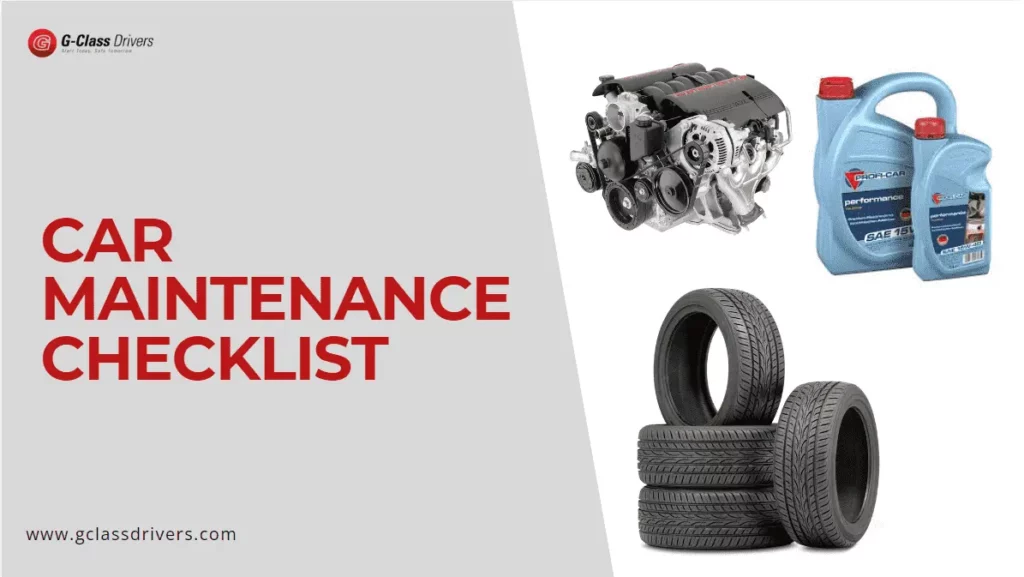Keep your ride in top shape! Learn how to take care of your car for smooth journeys, whether it’s working perfectly or has problems. We have a full car maintenance checklist to help you. It’s designed to make you feel confident while driving.
No one likes having to pay a mechanic. Maintaining your car is vital for its longevity and safety. Regular checkups are essential. Our car maintenance checklist offers a cost-effective way to care for your vehicle. This checklist ensures your car runs smoothly and remains in good condition. It minimizes engine strain and extends the lifespan of various components. Drive with confidence, knowing your car is well-maintained and reliable.
Following the regular car maintenance checklist won’t completely stop accidents, but a car that works well can keep you safer and save you money. So what maintenance does a car need? To maximize the performance of your car the given guide will help you.
Read also: How to Choose Driving Instructors?
Vehicle Maintenance Checklist
Following are some important Vehicle maintenance checklists that will help you improve the performance and life of your motor vehicle:
Short-Term Check-Ups (Monthly Maintenance)
To keep your car well maintained you should do monthly or short-term checkups. These short-term checkups are simple things you should check every month. By doing these small tasks you can help prevent bigger problems in your car later.
1. Check Your Oil Level
If your car is making strange noises or running rough oil could be a reason. Low or dirty oil mostly causes this kind of problem, so you must check the oil of the engine. Checking the oil is easy you just open the hood, pull out the dipstick, clean it, and dip it back in. If the oil level is low or the oil looks dark, it’s time to top up or change it. The oil keeps the engine parts working smoothly and stops them from overheating. Driving with low or dirty oil can damage your engine.
2. Check Tire Pressure and Condition
A tire blowout while driving can be scary and dangerous. Checking your tire pressure can help prevent this. Tires that are too full or too flat can wear out faster, use more gas, and even lead to a flat. Get a tire pressure gauge and check your tires every month. Also, check for cracks, bulges, or nails. Keeping your tires properly inflated helps them last longer, improves fuel efficiency, and makes your car safer to drive.
3. Check Fluid Levels
Imagine your brakes feel soft or your car overheats on the road—this can happen if your fluids are too low. Your car needs different fluids to run properly, like brake fluid, coolant, transmission fluid, and power steering fluid. Check these every month. Fluids help keep the engine and other parts running smoothly. If fluids run low, your car can break down or stop working.
4. Check Lights (Headlights, Brake Lights, Indicators)
Driving with a broken headlight or brake light is dangerous, especially at night or in bad weather. It can also get you pulled over. Once a month, walk around your car and check the headlights, brake lights, and indicators. Ask someone to help you by turning the lights on while you check them. Working lights help you see better and make sure other drivers can see you.
5. Check Wiper Blades and Washer Fluid
Driving in the rain with bad wipers is frustrating and unsafe. If your wipers leave streaks or don’t clear the windshield, it’s time to replace them. Don’t forget to fill up the washer fluid so you can clean your windshield when needed. Clear vision is important for safe driving, especially in rain or snow. Old or damaged wipers make driving in bad weather risky.
Medium-Term Check-Ups (Every 3-6 Months)
These are things you should check every three to six months. They don’t need to be done as often but are still important.
1. Air Filter
If your car feels weak or uses more gas than usual, the air filter might be dirty. The air filter stops dirt from getting into your engine. When it’s dirty, your engine can’t “breathe” properly. Check it every few months and replace it if it looks dirty. A clean air filter helps the engine work better, improves fuel efficiency, and reduces pollution.
2. Battery Condition
Has your car ever refused to start on a cold morning? That’s usually because the battery is weak. Car batteries don’t last forever. Every few months, check your battery for corrosion or leaks and make sure it’s charging properly. If your battery is old, consider replacing it before it dies. A good battery helps your car start easily, especially in cold weather.
3. Check Belts and Hoses
If you hear a squealing noise when you start the car or turn the steering wheel, a worn belt might be the problem. Belts and hoses are important for things like power steering and the cooling system. Check them every few months for cracks or leaks. Healthy belts and hoses keep your engine and other parts working smoothly.
4. Rotate Tires
Tires can wear out unevenly if they aren’t rotated regularly. Uneven tires make for a bumpy ride and can wear out faster. Rotating your tires every few months helps them wear evenly and last longer. Rotating your tires gives you a smoother ride, and better handling, and saves you money by making your tires last longer.
Long-Term Check-Ups (Yearly Maintenance)
These checks should be done once a year to make sure your car stays in good shape for the long run.
1. Brake System
If your brakes make a squealing or grinding noise, the brake pads might be worn down. It’s important to check your brakes every year. Make sure the pads, rotors, and brake fluid are in good condition. Your brakes are the most important safety feature in your car. Keeping them in good shape helps prevent accidents.
2. Suspension System
If your car feels bumpier than usual, your suspension might be worn out. This can affect how your car handles. An annual check of your shocks and struts can catch these problems early. A good suspension system gives you a smooth ride and keeps your car handling properly.
3. Transmission Fluid
If your car has trouble changing gears or isn’t accelerating like it should, your transmission fluid might need to be changed. An annual check can prevent costly transmission repairs. Transmission fluid keeps your gears shifting smoothly. Without it, the transmission can get damaged.
4. Wheel Alignment and Balance
If your car pulls to one side or your tires wear unevenly, it might need an alignment. Aligning your wheels once a year helps your car handle better and keeps your tires from wearing out too quickly. Proper alignment makes driving smoother and safer and helps your tires last longer.
5. Spark Plugs
If your car is hard to start or the engine misfires, it might be time to replace the spark plugs. Spark plugs ignite the fuel in the engine. They should be replaced once a year or as recommended by your car’s manual. Healthy spark plugs help your car run better and use fuel more efficiently.
Seasonal Check-Ups
Each season brings different challenges, so it’s important to adjust your car’s maintenance based on the weather.
Winter Maintenance
- Check Battery: Cold weather can drain your battery. Make sure it’s charged before winter.
- Winter Tires: Switch to winter tires for a better grip on snow and ice.
- Check Antifreeze: Make sure your antifreeze is at the right level so your engine doesn’t freeze.
Summer Maintenance
- Check Air Conditioning: Make sure your AC is working properly before the hot weather hits.
- Check Cooling System: Hot temperatures can cause your engine to overheat. Keep your cooling system in check.
- Check Tire Pressure: Heat can increase tire pressure, so check it regularly during the summer.
Conclusion
In conclusion, the car maintenance checklist can help you prevent accidents and can make your car safer. Thorough vehicle maintenance is an essential practice that directly contributes to the performance and longevity of your car. By paying attention to key aspects that include tire condition, engine oil and fluid levels, tire rotation, air and cabin filters cleanliness, spark plug efficiency, windshield wiper effectiveness, and brake system condition, you not only ensure your own safety but also extend the life of your vehicle. Neglecting these critical elements can lead to decreased fuel efficiency and costly repairs in the long run. Regular inspections help you resolve minor issues before they escalate into major problems. Ultimately, routine vehicle checks are a small price to pay that can save you from big issues. By following these guidelines, you can enjoy safer travels, smoother rides, and a more reliable vehicle for years to come.
FAQs
What routine maintenance is required for a car?
Routine maintenance includes oil changes, tire rotations, checking fluid levels, replacing air filters, and inspecting brakes.
What is the most basic maintenance for a car?
The most basic maintenance is changing the oil and oil filter regularly to keep the engine running smoothly.
How to do a maintenance checklist?
Create a checklist by including tasks like checking fluids, inspecting tires, brakes, lights, and batteries, and scheduling regular oil changes and filter replacements.
What are the four parts of the car’s checklist?
- Fluids
- Tires
- Brakes
- Battery
What is general maintenance?
General maintenance involves regular servicing like oil changes, tire checks, fluid top-ups, and inspecting key components to keep the car in good condition.
When to replace spark plugs?
Spark plugs should typically be replaced every 30,000 to 100,000 miles, depending on the vehicle and manufacturer’s recommendations.
Read More





